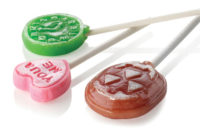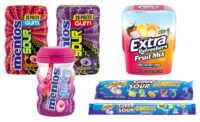
For the past five years, the organic confectionery market has ridden three key food trends hard - healthy, premium and convenience - and with great success. But even as spirited a stallion named “organic” found it slow going during the Great Recession - consumer caution creating a muddied and sloppy track, while higher ingredient and distribution costs within the organic sector weighed down a jockey used to spectacular showings.
Nevertheless, this pony refuses to give up the winner’s circle. Although the winnings still represent a small portion of total confectionery industry sales, organic confections continue to capture races and outrun mainstream growth.
Going forward, four additional trends will continue to energize sustained industry growth of organic confections: continued expansion of organic products in mainstream distribution channels; persistent food quality scares that drive consumers to safer, organic alternatives; the rise in purchasing power of younger generations of consumers weaned on organic food; and greater public concern over producer welfare and environmental stewardship issues.
That said, this market does face several significant, slippery turns. Supply constraints and high commodity costs keep organic confectionery retail prices at the premium level, which may not be the best niche given a protracted recession. Moreover, an ongoing debate over the nutritional merits of organic, versus less expensive natural products, may tarnish the halo surrounding organic products.

Is organic really better?
The year’s biggest controversy surfaced when the Food Standards Agency, Britain’s food industry regulators, published a report that concluded there was no health or nutritional benefit to organic food versus conventionally produced food.These conclusions quickly were refuted by the French food agency, AGSSA, whose review found higher levels of iron, magnesium and antioxidant polyphenols in organic products. Other critics of the British study pointed out that organic food products offer additional health benefits such as no pesticide residues, hormones or GMOs.
Despite the report’s potentially damaging conclusions, it didn’t seem to have any impact on consumer spending on organic confections in the United States.
Sales of organic confections through food, drug and mass merchandiser (FDM) channels increased 17% in the 52-week period ending August 2, 2009, reports SPINS, a market research and consulting firm for the natural products industry. Amazingly, the sales pace differs by only 1% from the previous 52-week period.
Nevertheless, closer scrutiny of sales statistics reveals that this race wasn’t a cake walk. First, sales in the beginning of 2009 were particularly hard hit. The premium sector also suffered, anecdotal evidence suggests. And yet, when viewed from a year-to-year perspective, the organic confectionery market demonstrated extraordinary resistance to the recession.
When seen in context of the entire confectionery market - sales grew a marginal 1.9% over the same period as reported by IRI - organic confections have outpaced the industry by eightfold. Further, organic confectionery sales increases were reflected in both dollar and unit sales growth, while total confectionery sales growth resulted more from price increases.

For example, organic lollipop maker Yummy Earth assembled assorted value packs and, together with price concessions for its distributor, priced them aggressively.
Chocolate maker Theo released Classic Flavor Combination, a line of value-priced (SRP $3.99 for a 3-oz. bar) bars in mainstream flavors. A number of marketers engaged in product downsizing, including Dagoba’s Tasting Squares 0.32-oz chocolate pieces, Clif Bar’sLuna Minis(0.7 oz.) and Essential Living FoodsEverything Raw (0.7 oz.), to name just a few examples.
To no one’s surprise, the top-selling organic confectionery category remained energy bars ($147.2 million), followed by snacks ($82.6 million) and candy ($48.2).
As mentioned earlier, organic confectionery sales are a small niche within the total confectionery marketplace, with only 2% market share.

Energy bars dominate
Within the segment, energy bars had the greatest penetration rate (25.1%), followed by snacks (1.9%) and candy (0.5%). At the same time, it’s important to note that categories within the organic confectionery market differ significantly from those in the total confectionery market. Energy bars comprise 53% of organic confectionery sales, but only 4% of the total confectionery market, reflecting the importance of lifestyle and wellness products for organic consumers.Candy, including chocolate, non-chocolate and gum/mint sales, accounts for the largest percentage of sales (66%), whereas in organic confections, organic gums are not a factor.
Although organic confection sales may not attain the explosive 40%-50% annual sales gains of several years ago when the market was younger, they should continue to expand at half those growth rates, which still make the market attractive when compared with single-digit sales increases for conventional candy counterparts.
Vreeland & Associates, a confectionery market research consultancy, forecasts total organic retail confectionery sales will double from $926 million in 2009 to $1.830 billion in five years (2014). This represents a 20% compound annual growth rate, double the growth of the global food market as forecast by Marketline’s Organic Food Global Industry Guide.

Lifestyles play critical role
A major factor in supporting continued robust growth are lifestyle and wellness bars. Sales within this category surged by 35% last year, helping the segment rack up a 3-year, 35% compound annual growth rate. Clearly, bar consumers have imbedded these products in their normal diet routine, be it as a meal replacement or a snack. And at the typical $1.50 to $2.50 price range, they are affordable even during gloomy economic times.In reviewing this year’s top ten organic confectionery trends - based on new product introductions and product claim statistics - five have a familiar ring to them, carrying over from 2007: gluten-free, healthier sweetener options, dark chocolate, bite-sized packs and Fair Trade. New trends emerging this year are minimal ingredient, vegan, raw, cocoa seeds/nibs and EcoSocial certification.
Introduced in the United States by organic ingredient supplier Global Organics, EcoSocial is a new attempt at combining social, environmental (sustainable and organic) and economic (Fair Trade) into one umbrella certification.

Of the 228 new SKUs, 80% were chocolate. Total new confections introductions dropped by 5.9%, mostly in the non-chocolate candy and gum categories.
Vreeland & Associates has identified more than 100 manufacturers who sell certified organic confectionery products in the U.S. market. These manufacturers were interviewed regarding new product pricing, claims and attributes. A sampling of new products were collected and analyzed.
Of these new products, 48% were in the chocolate category, reflecting the continued demand for premium and dark chocolate. The lifestyle/wellness bar category was second (22%), an increasingly crowded field where success can only be won by satisfying the nutritional needs of specific niche markets.
Non-chocolate and individual snacks were third (13%), driven by demand for non-sugary snacks. Dried fruit (4%) was relegated to fourth place, while no new mint or gum introductions surfaced.
With regards to organic confectionery flavor profiles, Product Launch Analytics ranked the following as the top five: blends, dark chocolate, milk chocolate, chocolate and orange. This ranking is almost identical with 2007 (2008 data was unavailable), except that orange knocked cranberry for the No. 5 spot. The inclusion of cocoa and cacao in the top 20 list of flavors provides evidence that because of chocolate’s widely reported health benefits, there’s been a surge in popularity.

Thanks to growing concerns about sucrose in blood levels, healthier sweetener options, which are most frequently found in non-chocolate candy and dried fruit products, surfaced as the third most popular claim in organic confectionery launches.
Fair Trade-certified and GMO-free secured the fourth and fifth most popular claims ranking. Still, it’s a bit surprising to see GMO-free as a claim, given the inherent absence of GMO-ingredients when a product is labeled organic. The finding suggests that either consumers still do not understand the standard definition of organic food or that marketers are cluttering their packaging with unnecessary claims.
Superfruit/superfood claims broke into 2009’s top 15 new product claims rankings, while omega-3 and preservative-free, which were prominent in 2007 list, fell from the top ranking.
One can expect more claims to surface next year as consumers intensify their preference for all things natural. And as the economy gradually recovers, less penny-conscious consumers will translate into increased sales for the category. Certainly, this horse is poised to break from the gate as consumer confidence returns.
The following was excerpted from Vreeland & Associates’ upcoming report on the state of the U.S. organic confectionery market.
For more information, visitwww.vreelandassociates.com.






